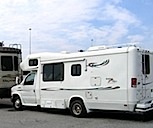We have been to Chartres and Chambord. Chartres is another old city with a cathedral, but this one is not just yet another in a series--it stands out from the rest. It isn’t the biggest or the tallest, but it might well be the most beautiful, thanks especially to its magnificent stained glass windows. And they have actually been cleaning it! and them! Most of these places haven’t been touched in years and years, but parts of Chartres’s have been thoroughly cleaned and repaired.

We were fortunate to hear part of an organ practice and, later, some of an organ recital; then at night we heard a Swiss choir perform. David said it was funny to hear a French organist playing German Lutheran music (Bach) in a Roman Catholic cathedral.
Besides being a lovely town, Chartres has a great campground about a mile and a half from the old city and cathedral. It’s in a park along a river with a bike path through a wood and the park to the bottom of some very steep hills to the city center. We took our bikes into the city three times, including once returning after dark so we could see the iluminated buildings. It rained on us a bit, but not enough to dampen our spirits. It is a charming place--highly recommended--only a short train ride from Paris.
After two nights in Chartres we drove all of 21 miles to Bonneval on a Sunday, when just about everything was closed. The guide book advised campers not to approach the town from the south, as the streets are too narrow. (You don’t have to warn us about that more than once; nevertheless, even from the north we had to go through some tight spots to get to the campground, and we had to do it again in the morning when we left.) We walked into the town and found the old church open, but with no one else in it. Then we walked around the town a little: only a bar was open. (About the picture below: the sign indicates 3 meters of clearance in height, but the arch is clearly taller than that--3 meters wide, though, I can believe.)

As Americans who have become accustomed to removing shoes and belts before entering even a courthouse, let alone a national monument, we’ve been amazed that these beautiful, ancient buildings are not guarded or secured in any way. No one is checking backpacks or bags; there are people pulling luggage and pushing strollers; we even saw one boy in Amiens Cathedral with a scooter over his shoulder.
It was the same way at Chambord, a huge chateau built by Francois I for a hunting lodge: four floors and towers of stone and carvings and not a guard in sight except at the entrance. It is a very beautiful place that has gone through many restorations. Because it had been abandoned for years and then used for art storage during WWII, most of the rooms were quite empty, but it is a work in progress. An easy access parking lot was provided for buses and motorhomes. It is a popular place.
We then stayed in Blois at a free camping place on the banks of the River Loire (click on the photo below for a larger version). It had no services (no electricity or water, let alone dumping)--just a place to stay for the night. About a dozen motorhomes were parked there with us, and several people, seeing our Minnesota license plates, stopped to ask about Rover and how we got there. Blois (pronounced ‘Blwah’--nearly impossible to say) has such an old city center that some of the streets turn into long flights of stairs. And, of course, it has its own chateau.

I (Susan) have learned the French word for sauerkraut (choucrout) and will not forget it. We went out to dinner in Chartres, and I ordered what turned out to be a huge pile of sauerkraut (like a pile of pasta) with one large peeled boiled potato and five different pieces of meat--sort of: a slice of very good ham, one hot-dog-looking sausage, another kind of sausage, one slice of an even larger and fattier sausage, and one strip of that thick dried uncooked-looking bacon that is eaten in Europe. All in all, a most unappetizing meal. But, c’est la vie, it’s all part of the adventure.

